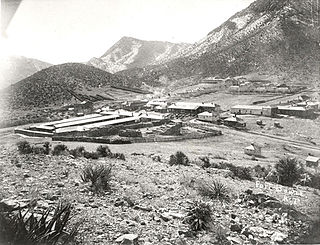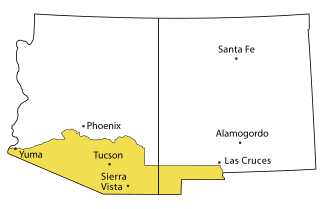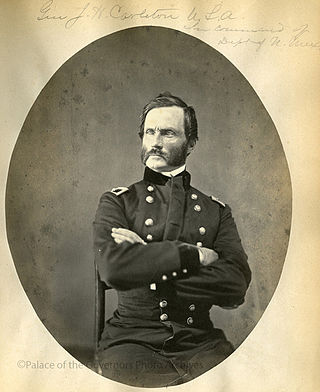
Cochise was the leader of the Chiricahui local group of the Chokonen and principal nantan of the Chokonen band of a Chiricahua Apache. A key war leader during the Apache Wars, he led an uprising that began in 1861 and persisted until a peace treaty was negotiated in 1872. Cochise County is named after him.

George R. Crook was a career United States Army officer who served in the American Civil War and the Indian Wars. He is best known for commanding U.S. forces in the 1886 campaign that led to the defeat of the Apache leader Geronimo. As a result, the Apache nicknamed Crook Nantan Lupan, which means "Grey Wolf."

Arizona Territory, colloquially referred to as Confederate Arizona, was an organized incorporated territory of the Confederate States that existed from August 1, 1861, to May 26, 1865, when the Confederate States Army Trans-Mississippi Department, commanded by General Edmund Kirby Smith, surrendered at Shreveport, Louisiana. However, after the Battle of Glorieta Pass, the Confederates had to retreat from the territory, and by July 1862, effective Confederate control of the territory had ended. Delegates to the secession convention had voted in March 1861 to secede from the New Mexico Territory and the Union, and seek to join the Confederacy. It consisted of the portion of the New Mexico Territory south of the 34th parallel, including parts of the modern states of New Mexico and Arizona. The capital was Mesilla, along the southern border. The breakaway region overlapped Arizona Territory, established by the Union government in February 1863.

The New Mexico campaign was a military operation of the trans-Mississippi theater of the American Civil War from February to April 1862 in which Confederate Brigadier General Henry Hopkins Sibley invaded the northern New Mexico Territory in an attempt to gain control of the Southwest, including the gold fields of Colorado and the ports of California. Historians regard this campaign as the most ambitious Confederate attempt to establish control of the American West and to open an additional theater in the war. It was an important campaign in the war's Trans-Mississippi Theater, and one of the major events in the history of the New Mexico Territory in the American Civil War.

Apache Pass, also known by its earlier Spanish name Puerto del Dado, is a historic mountain pass in the U.S. state of Arizona between the Dos Cabezas Mountains and Chiricahua Mountains at an elevation of 5,110 feet (1,560 m). It is approximately 20 miles (32 km) east-southeast of Willcox, Arizona, in Cochise County.

Stanwix Station, in western Arizona, was a stop on the Butterfield Overland Mail Stagecoach line built in the later 1850s near the Gila River about 80 miles (130 km) east of Yuma, Arizona. Originally the station was called Flap Jack Ranch later Grinnell's Ranch or Grinnell's Station. In 1862, Grinnell's was listed on the itinerary of the California Column in the same place as Stanwix Ranch which became the site of the westernmost skirmish of the American Civil War. A traveler in 1864, John Ross Browne, wrote Grinnell's was six miles southwest of the hot springs of Agua Caliente, Arizona.

The California Column was a force of Union volunteers sent to Arizona and New Mexico during the American Civil War. The command marched over 900 miles (1,400 km) from California through Arizona and New Mexico Territory to the Rio Grande and as far east as El Paso, Texas, between April and August 1862.

Fort Bowie was a 19th-century outpost of the United States Army located in southeastern Arizona near the present day town of Willcox, Arizona. The remaining buildings and site are now protected as Fort Bowie National Historic Site.

The New Mexico Territory, comprising what are today the U.S. states of New Mexico and Arizona, as well as the southern portion of Nevada, played a small but significant role in the trans-Mississippi theater of the American Civil War. Despite its remoteness from the major battlefields of the east, and its being part of the sparsely populated and largely undeveloped American frontier, both Confederate and Union governments claimed ownership over the territory, and several important battles and military operations took place in the region. Roughly 7,000-8,000 troops from the New Mexico Territory served the Union, more than any other western state or territory.

The 1st Regiment California Volunteer Infantry was an infantry regiment in the Union Army during the American Civil War. It spent its entire term of service in the western United States.

Prior to the adoption of its name for a U.S. state, Arizona was traditionally defined as the region south of the Gila River to the present-day Mexican border, and between the Colorado River and the Rio Grande. It encompasses present-day Southern Arizona and the New Mexico Bootheel plus adjacent parts of Southwestern New Mexico. This area was transferred from Mexico to the United States in the Gadsden Purchase of 1853. Mining and ranching were the primary occupations of traditional Arizona's inhabitants, though growing citrus fruits had long been occurring in Tucson.
The Battle of Cookes Canyon was a military engagement fought between settlers from Confederate Arizona and Chiricahua Apaches in August 1861. It occurred about 40 miles (64 km) northwest of Mesilla, in Cookes Canyon. The exact date of the battle is unknown. The battle occurred in the larger context of both the Apache Wars and the American Civil War.
The Company A, Arizona Rangers was a cavalry formation of the Confederate States Army during the American Civil War.

Union forces entered Tucson on May 20, 1862, with a force of 2,000 men without firing a shot.

Presidio San Agustín del Tucsón was a presidio located within Tucson, Arizona, United States. The original fortress was built by Spanish soldiers during the 18th century and was the founding structure of what became the city of Tucson. After the American arrival in 1846, the original walls were dismantled, with the last section torn down in 1918. A reconstruction of the northeast corner of the fort was completed in 2007 following an archaeological excavation that located the fort's northeast tower.

The Battle of Mount Gray was an engagement of the Apache Wars fought at the foothills of Gray Mountain on April 7, 1864. A troop of the United States Army's California Column attacked a superior force of Chiricahua Apaches at their camp and routed them from the field.

James Henry Carleton was an officer in the US Army and a Union general during the American Civil War. Carleton is best known as an Indian fighter in the Southwestern United States.

Dragoon Springs is an historic site in what is now Cochise County, Arizona, at an elevation of 4,925 feet (1,501 m). The name comes from a nearby natural spring, Dragoon Spring, to the south in the Dragoon Mountains at 5,148 feet (1,569 m). The name originates from the 3rd U.S. Cavalry Dragoons who battled the Chiricahua, including Cochise, during the Apache Wars. The Dragoons established posts around 1856 after the Gadsden Purchase made the area a U.S. territory.



















